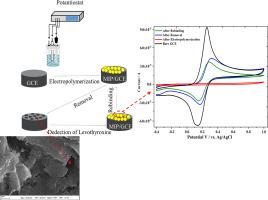Design of an electrochemical sensor based on 3-thiophene methanol and 3-methylthiophene supported molecularly imprinted polymer for the sensitive and selective detection of levothyroxine
IF 4.9
2区 化学
Q1 CHEMISTRY, ANALYTICAL
引用次数: 0
Abstract
Levothyroxine (L-T4) is the most frequently prescribed drug to treat thyroid hormone deficiency. Herein, a levothyroxine-specific sensor was designed using the molecular imprinting method to increase the selectivity of the target molecule on the electrode surface and prevent interference effects. 3-thiophene methanol (3-TMeOH) and 3-methyl thiophene (3-MT) monomers were electro-polymerized as molecularly imprinted polymer (MIP) on the surface of a glassy carbon electrode (GCE) in the presence of L-T4. Gaps were created on the surface of the designed electrode to fit the target molecule by removing L-T4 molecules. This way, L-T4-specific selective structures were formed on the sensors' surface. The results showed that under optimized conditions, the fabricated modified sensor (3-TMeOH/3-MT@MIP/GCE) exhibited a linear response in the concentration range of 1.0–5.7 μM with limit of determination, limit of quantitation, and sensitivity values of 1.83 nM, 5.50 nM, and 0.0023 A.L.mmol−1.cm−2, respectively. The analytical method validation process of the voltammetric determination method using the sensor selective to L-T4 was completed following the method's intended use. The designed modified sensor exhibited high sensitivity, repeatability, excellent stability, selectivity, and high precision and accuracy.

基于3-噻吩-甲醇和3-甲基噻吩负载的分子印迹聚合物的电化学传感器的设计用于左甲状腺素的灵敏和选择性检测
左旋甲状腺素(L-T4)是治疗甲状腺激素缺乏症最常用的处方药。为了提高靶分子在电极表面的选择性,防止干扰效应,采用分子印迹法设计了左旋甲状腺素特异性传感器。在L-T4存在下,3-噻吩甲醇(3-TMeOH)和3-甲基噻吩(3-MT)单体在玻璃碳电极(GCE)表面作为分子印迹聚合物(MIP)电聚合。通过去除L-T4分子,在设计的电极表面产生间隙以适应目标分子。通过这种方式,在传感器表面形成了l - t4特异性的选择性结构。结果表明,在优化条件下,制备的改性传感器(3-TMeOH/3-MT@MIP/GCE)在1.0 ~ 5.7 μM的浓度范围内具有良好的线性响应,检测限、定量限和灵敏度分别为1.83 nM、5.50 nM和0.0023 a.l.m olmmol−1 cm−2。采用L-T4选择性传感器的伏安测定方法的分析方法验证过程按照该方法的预期用途完成。该传感器具有灵敏度高、重复性好、稳定性好、选择性好、精密度和准确度高等特点。
本文章由计算机程序翻译,如有差异,请以英文原文为准。
求助全文
约1分钟内获得全文
求助全文
来源期刊

Microchemical Journal
化学-分析化学
CiteScore
8.70
自引率
8.30%
发文量
1131
审稿时长
1.9 months
期刊介绍:
The Microchemical Journal is a peer reviewed journal devoted to all aspects and phases of analytical chemistry and chemical analysis. The Microchemical Journal publishes articles which are at the forefront of modern analytical chemistry and cover innovations in the techniques to the finest possible limits. This includes fundamental aspects, instrumentation, new developments, innovative and novel methods and applications including environmental and clinical field.
Traditional classical analytical methods such as spectrophotometry and titrimetry as well as established instrumentation methods such as flame and graphite furnace atomic absorption spectrometry, gas chromatography, and modified glassy or carbon electrode electrochemical methods will be considered, provided they show significant improvements and novelty compared to the established methods.
 求助内容:
求助内容: 应助结果提醒方式:
应助结果提醒方式:


